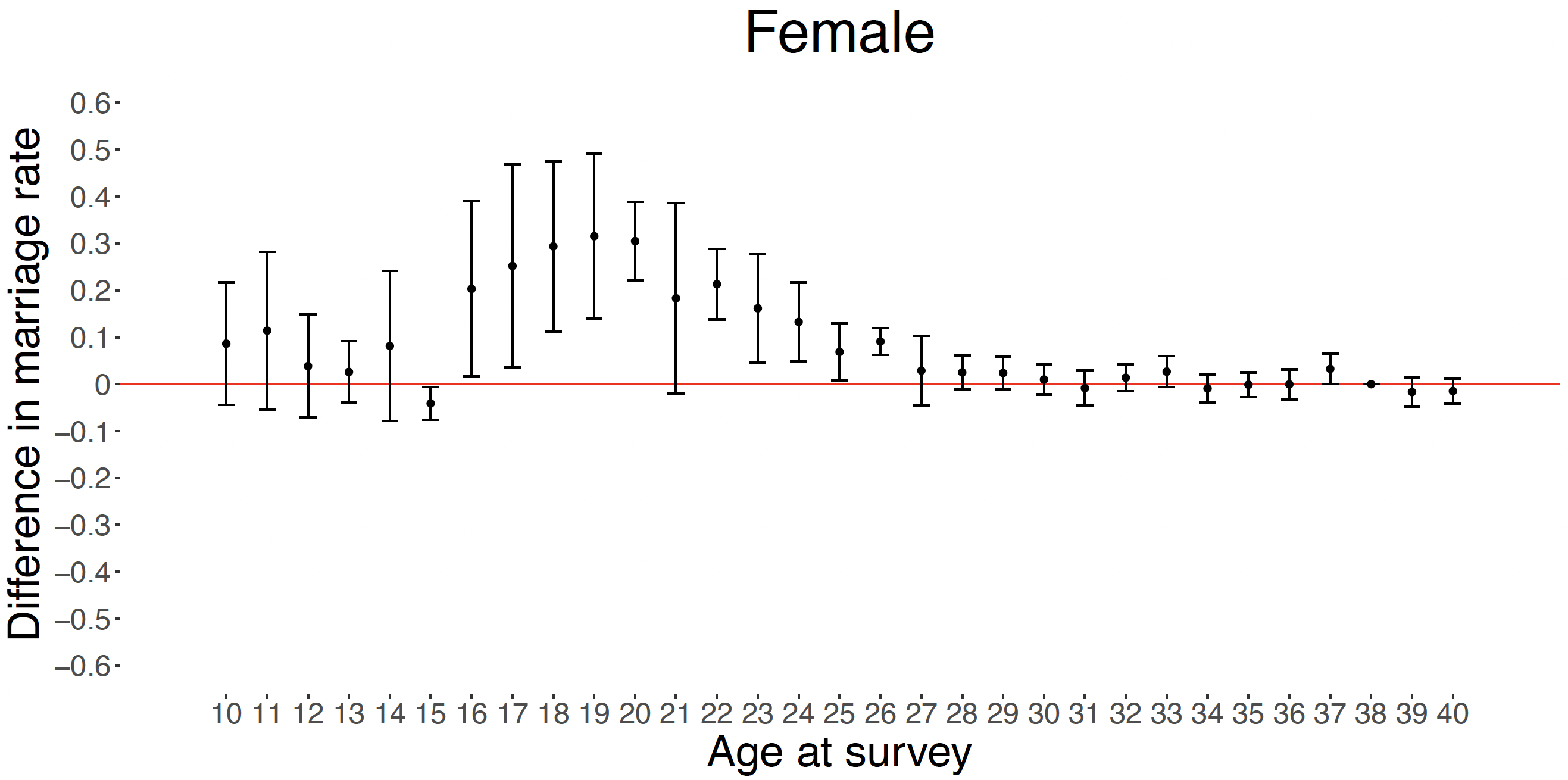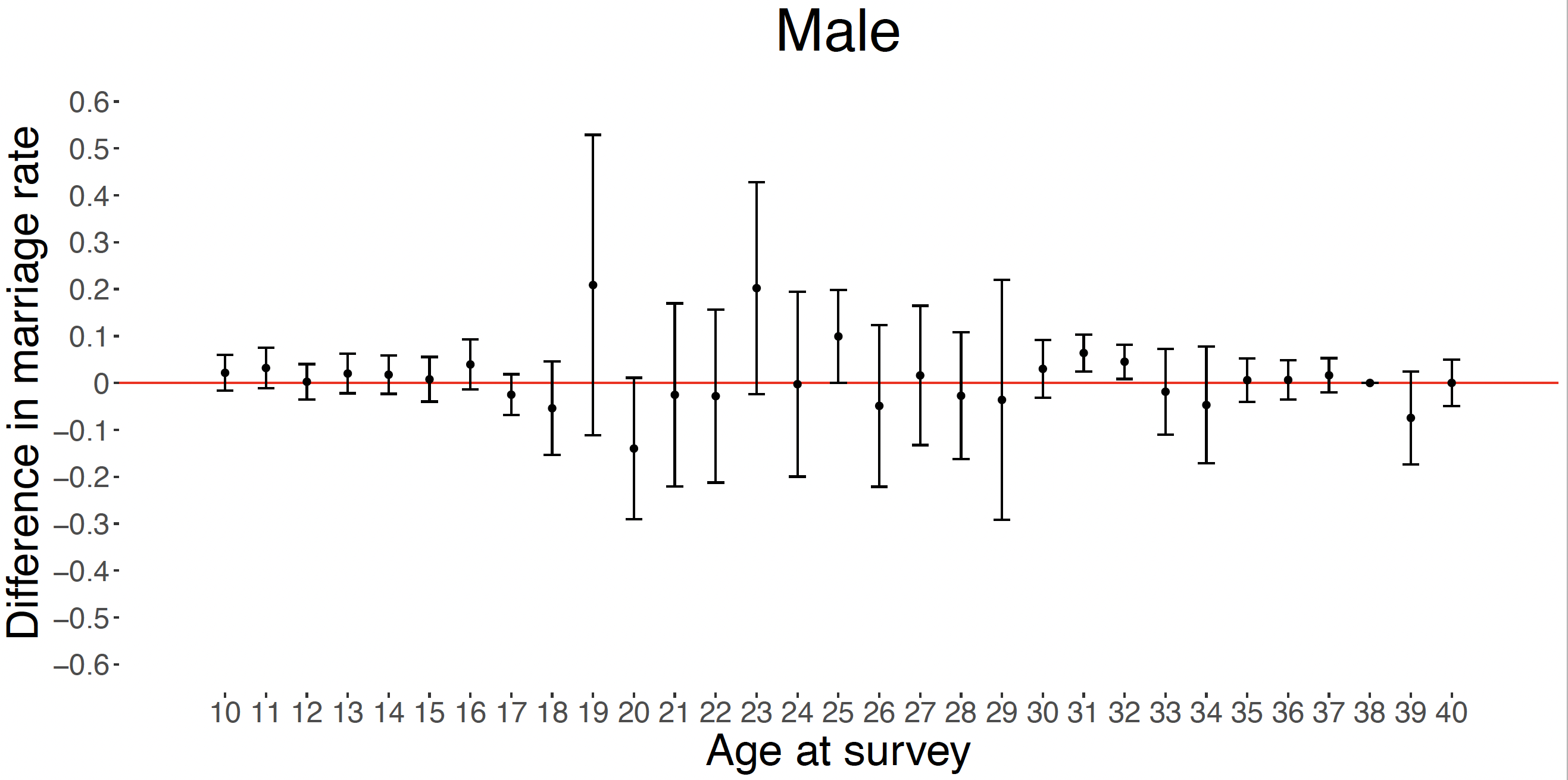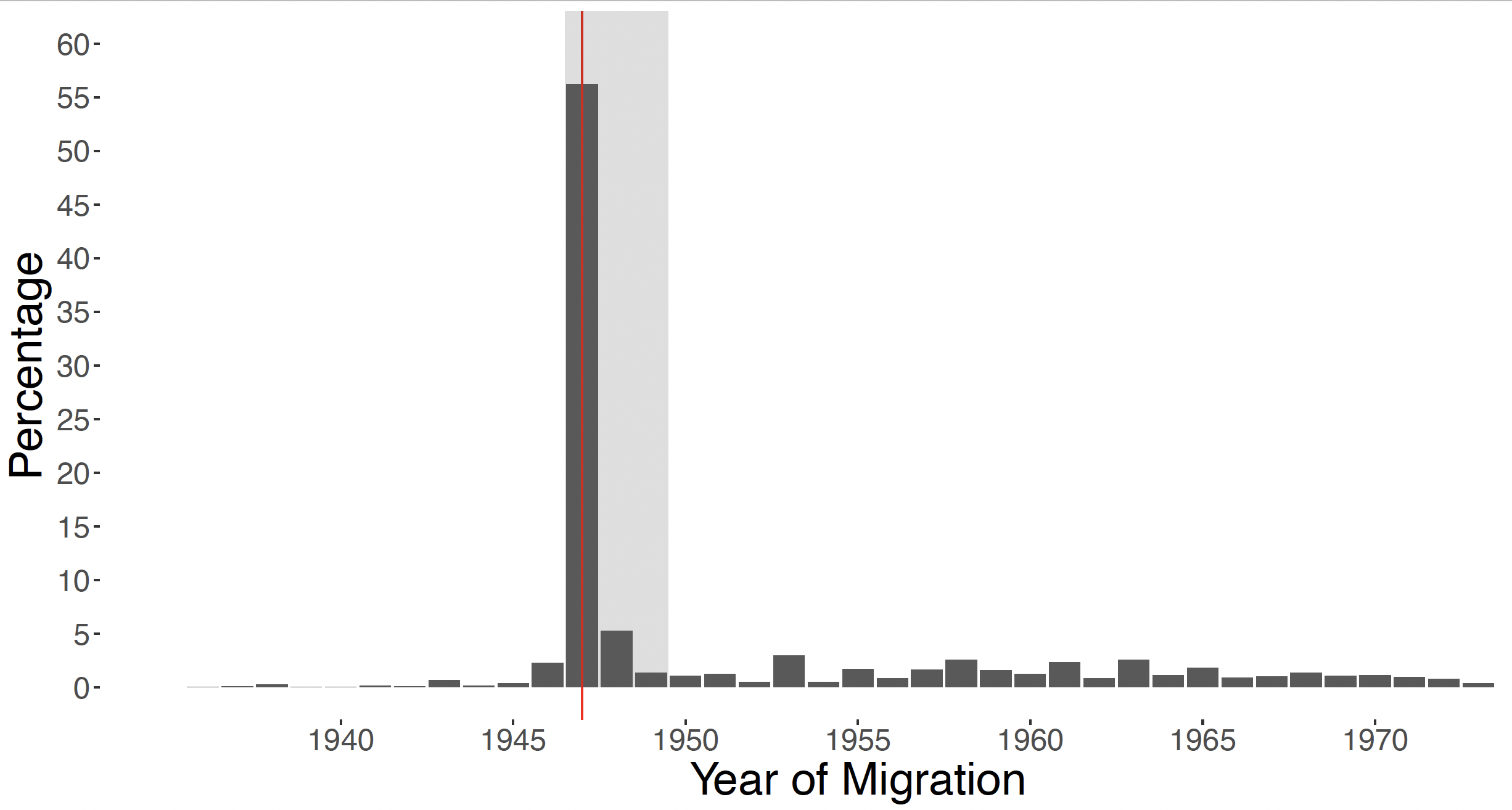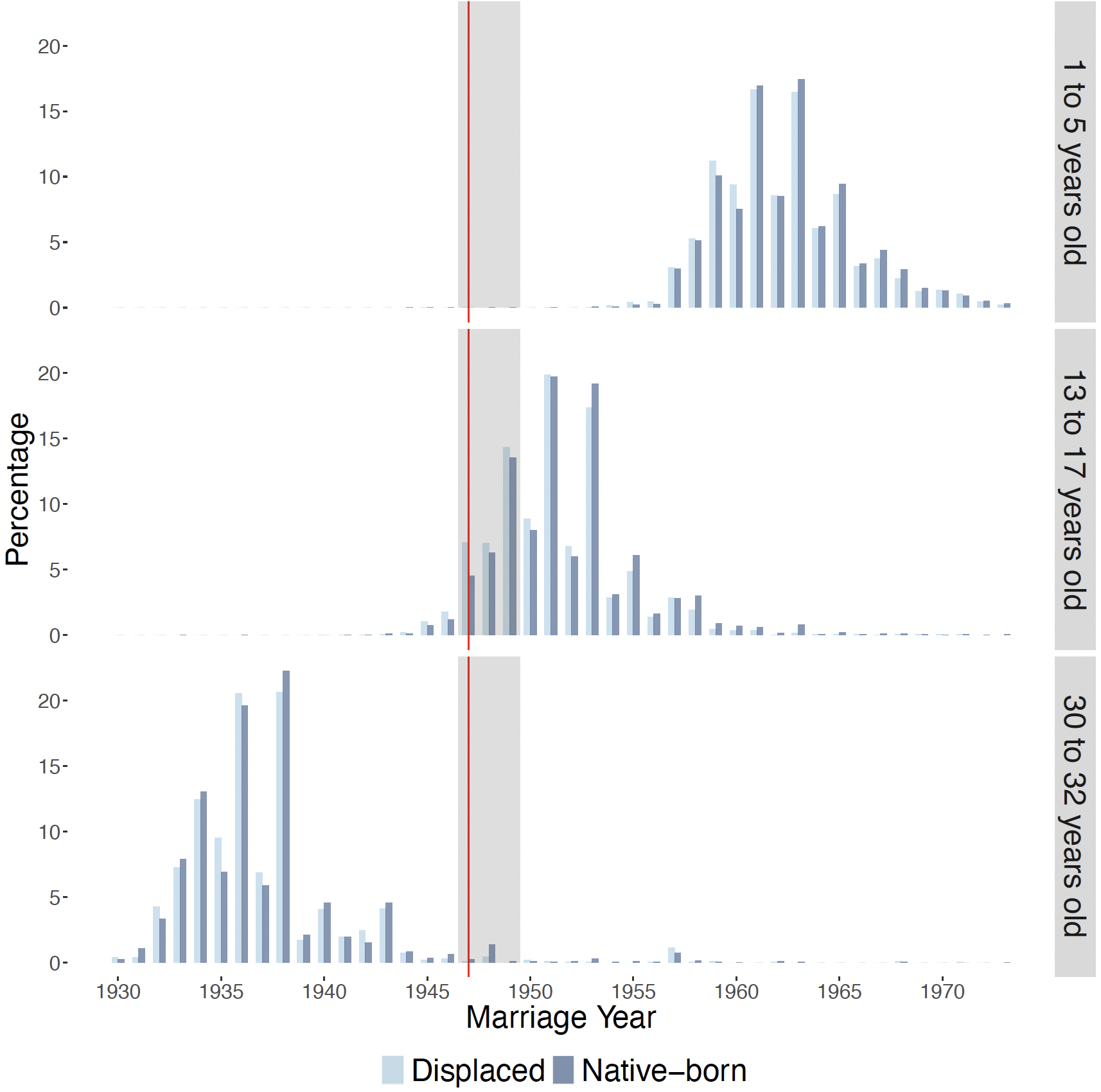
Forced migration can create conditions that lead to early marriage for adolescent women
Displacement, or forced migration, generates tremendous risks, ranging from loss of life and property to the possibility of long-term physical and psychological harm.1 Empirical research on the impacts of displacement on individuals is notoriously difficult because of issues such as non-random selection of displaced populations, lack of data during periods of displacement, selection due to mortality, choice of destination, and so on. Yet, such research is crucial because millions of people are displaced every year (UNHCR 2019) and millions are at risk of displacement due to political, economic, or climate-related reasons (iDMC 2017).
Women and children are made particularly vulnerable by displacement. The high incidence of gender-based violence towards displaced women has been well-documented (UNHCR 2003, Brookings Institution 2014). Displaced girls may also be particularly vulnerable to child marriage (Brookings Institution 2019, UNICEF 2014). Marriage-related outcomes – such as age at marriage and partner characteristics – have been shown to impact human capital investments and long-term fertility outcomes (Jensen and Thornton 2003, Field and Ambrus 2008). In our study (Lu, Siddiqui, and Bharadwaj 2021) we contribute to the research evidence on the impacts of displacement on women and children by studying their marriage market outcomes.
Cross-country evidence shows displaced adolescent women have higher marriage rates
Using 12 representative datasets across seven countries, we document differences in age-specific marriage rates between recently displaced women and non-migrant women as an informative descriptive exercise.2 These surveys, which publicly available from IPUMS International, contain information on the cause and timing of the respondent’s most recent migration as well as marital status. We define recently displaced individuals as a subset of migrants whose cause of migration was insecurity, war, violence, or natural disaster and who migrated up to five years before the time of survey. Non-migrant women who have never migrated in their lifetime were chosen as the comparison group.3
Across nearly all the countries in our sample, displaced adolescent women have higher marriage rates than non-migrant women of the same age in the same dataset. This implies that being young and displaced leads to earlier marriage than being young and not displaced. We conduct the same analysis for displaced and non-displaced men and find little evidence of the same pattern. Figure 1 reports the age-specific marriage rate differences using data pooled across all datasets in the sample.
While the pattern we document is quite strong and consistent, it could be at least partially driven by factors other than displacement such as the non-random selection of displaced populations, and timing of displacement. To strengthen the evidence, we study the outcomes of women displaced during the large-scale migration episode caused by the partition of India in 1947.
Figure 1 Cross-country evidence-differences in age-specific marriage rates


Note: The figure shows the effects of displacement on age-specific marriage rates between recently displaced and non-migrant individuals of a given gender, as indicated along each panel. The dependent variable is whether the respondent has ever been married, and data is pooled over all countries and survey years, excluding the 1973 Pakistan survey.
Evidence from the partition of India in 1947
The end of British rule in India in August 1947 resulted in the partition of India into two countries: the Hindu-majority state of India and the Muslim-majority state of Pakistan. The partition led to one of the largest and most rapid migrations in human history. By 1951, an estimated 14.5 million people were displaced along religious lines, with 6.5 million displaced into Pakistan (Bharadwaj et al. 2008). We focus on Muslim women who were displaced into the Punjab province of Pakistan in the period right after partition. Figure 2 reports the migration timing of Indian-born women into Pakistani Punjab. A vast majority of displacement induced by partition occurred from 1947–1949. After partition, the sudden inflow of non-selected migrants who were culturally, ethnically, and linguistically similar to people from Indian Punjab means that Pakistani Punjab provides a unique opportunity to strengthen the evidence on the impact of displacement on marriage outcomes found in the cross-country analysis.
Figure 2 Migration timing of Indian born women into Pakistani Punjab

Note: The figure shows the empirical density of the year of last migration for women born in India. This is calculated as 1973 minus years since last migration, as reported in the 1973 Pakistan HED survey.
We use data from Pakistan’s 1973 Housing, Economic, Demographic Characteristics survey, which was collected approximately 25 years after partition. The survey data allows us to observe marriage timing (age at first marriage), spousal characteristics, education attainment, and long-term fertility for women. We define individuals displaced by partition as those who moved to their current locality in Pakistan during the peak migration period between 1947 and 1949.4
To identify the impact of displacement on the outcomes of young women, we use a difference-in-differences approach that compares the age trends in outcomes between displaced and native-born Pakistani women. We compare young, displaced women to two groups: older displaced women and native-born women. Older displaced women whose marriage timing was largely fixed at the time of partition serve as a comparison group to younger displaced women. Native-born women provide counterfactual age-cohort demographic trends.
We focus on studying the impacts of displacement on two age groups of ‘young women’. The first group is adolescents who were 13–17 years old at the time of partition. Most women have reached puberty by age 13, so this group may be particularly vulnerable to child marriage. The second group is young children who were 1–5 years old at the time of partition. This group allows us to cleanly identify the effects of displacement on education accumulation, as all educational attainment must have occurred after partition.
Figure 3 Marriage timing by age during partition

Note: The figure shows the year of marriage of displaced and native-born women across different age cohorts.
Figure 3 plots the empirical densities of the year of first marriage for native-born and displaced women by age group. Adolescent displaced women were 5.3 percentage points more likely to get married at the time of partition between 1947–1949. Consequently, the child marriage rate for adolescent displaced women increased by 3.4 percentage points (relative to a comparison mean of 11.4%). In addition, adolescent displaced women experienced higher fertility both in terms of births and surviving children.
In contrast, the impact on marriage timing for displaced female children (those aged 1–5 years at the time of partition) is much weaker. There is some evidence of delayed marriage, but the impacts are not statistically significant. Displaced children have higher levels of literacy and primary school completion. They do not have higher fertility in terms of children born but have more surviving children.5 Our results for both age groups are consistent with the existing literature on the impacts of early marriage on women (Jensen and Thornton 2003, Field and Ambrus 2008).
Potential mechanisms underlying higher marriage rates among displaced women
We emphasise three mechanisms that are consistent with our findings:
- The partition of India is particularly significant due to the scale and prevalence of violence against women that took place (Bhasin and Menon 1998, Butalia 2017, Das 2006). The salience of this risk may have induced families to marry off young women if married women were believed to be more protected by the presence of a male spouse.
- A second mechanism is the possibility of a negative wealth and income shock. Displacement is associated with the loss of physical property and assets. Additionally, displaced individuals face short and long-term income losses as they leave their pre-existing sources of income and are forced to relocate to places where there might be a lack of job opportunities (for example, refugee camps) or where their skills sets may not be well-suited (for example, rural to urban migration). Under these circumstances, displaced parents might consider marrying off their young daughters to alleviate financial constraints (Corno et al. 2020).
- Displacement events may generate changes in the composition of the marriage market that are consistent with our findings. Previous work (Bharadwaj et al. 2008) shows that the displaced population in Pakistan had higher male ratios than the non-displaced population. In our context, there were very low cross-marriage rates between displaced and native-born people. The excess supply of men might have differentially increased the demand for women among the displaced group and led to the earlier marriage of displaced women.
Though we are unable to provide direct evidence on any mechanism, consideration of these mechanisms is important as they might imply different welfare consequences for women. The current literature suggests early marriage has detrimental consequences for women through lower human capital investments and higher fertility (which our results are consistent with), but the question of what early marriage during a time of displacement means for women’s welfare is a crucial one which we are not able to answer fully. This is an important question for future research in this area.
References
Bharadwaj, P, A Khwaja and A Mian (2008), “The big march: Migratory flows after the partition of India”, Economic and Political Weekly, 39-49.
Brookings Institution (2014), “Improving the protection of internally displaced women: Assessment of progress and challenges”.
Brookings Institution (2019), “Forced Displacement and Child Marriage: A Growing Challenge in MENA”.
Butalia, U (2017), “The other side of silence: Voices from the partition of India”, Penguin UK.Corno, L, Hildebrandt, N, & Voena, A (2020), “Age of marriage, weather shocks, and the direction of marriage payments”, Econometrica 88(3): 879-915.
Das, V (2006), Life and words, University of California Press.
Field, E, & Ambrus, A (2008), “Early marriage, age of menarche, and female schooling attainment in Bangladesh”, Journal of Political Economy 116(5): 881-930.
iDMC - Internal Displacement Monitoring Centre (2017), Global Disaster Displacement Risk–A Baseline for Future Work, Geneva.
Jensen, R, & Thornton, R (2003), “Early female marriage in the developing world”, Gender & Development 11(2): 9-19.
Khalidi, O (1998), “From torrent to trickle: Indian Muslim migration to Pakistan, 1947—97”, Islamic Studies 37(3): 339-352.
Lu, F, S Siddiqui, and P Bharadwaj (2021), “Marriage outcomes of displaced women”, Journal of Development Economics 152: 102684.
Menon, R and K Bhasin (1998), Borders & boundaries: women in India's partition, Rutgers University Press.
Minnesota Population Center (2019), “Integrated Public Use Microdata Series”, International: Version 7.2 [dataset]. Minneapolis, MN.
UNHCR (2003), Sexual and Gender-Based Violence against Refugees, Returnees and Internally Displaced Persons-Guidelines for Prevention and Response, Geneva.
UNHCR (2019), Global Trends: Forced Displacement in 2018, Geneva.
UNICEF (2014), Ending child marriage: Progress and prospects.
Endnotes
1 Forced migration is defined as "movements of refugees and internally displaced people (those displaced by conflicts) as well as people displaced by natural or environmental disasters, chemical or nuclear disasters, famine, or development projects." (International Association for the Study of Forced Migration, IASFM)
2 These countries (with survey rounds in the listed years) are Armenia (2011), Cambodia (1998, 2004, 2008, 2013), Colombia (2005), India (1983, 1987, 1999), Iraq (1997), Kyrgyz Republic (2009), and Nepal (2011). All datasets are representative samples of population censuses except for the India surveys which are large, nationally representative employment surveys.
3 As we do not observe the full migration history for each woman, we choose non-migrant women as the main comparison group because there is no chance that they have been displaced in the past.
4 We choose to exclude the post-1949 Indian-born migrants from our definition of displaced (and the analysis) because we know from historical accounts these migrants most likely originate from India, rather than re-migrating within Pakistan; even within India they largely originate from central and southern states of India (as opposed to Indian Punjab) (Khalidi 1998); they are a self-selected group from among the remaining Muslims in those states, and their migration timing is very likely endogenous. Our results are robust to including women who migrated in later years, up to the year of 1953.
5 Women who were 1–5 years old at partition are around 26-31 years old at the time of the survey. At the very least, our results show that displaced women in the 1–5 age group did not have children earlier than their native-born counterparts.



